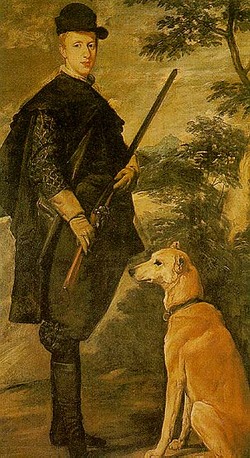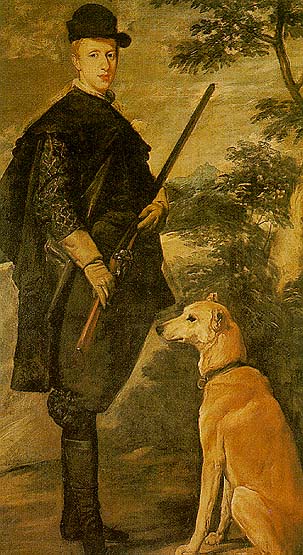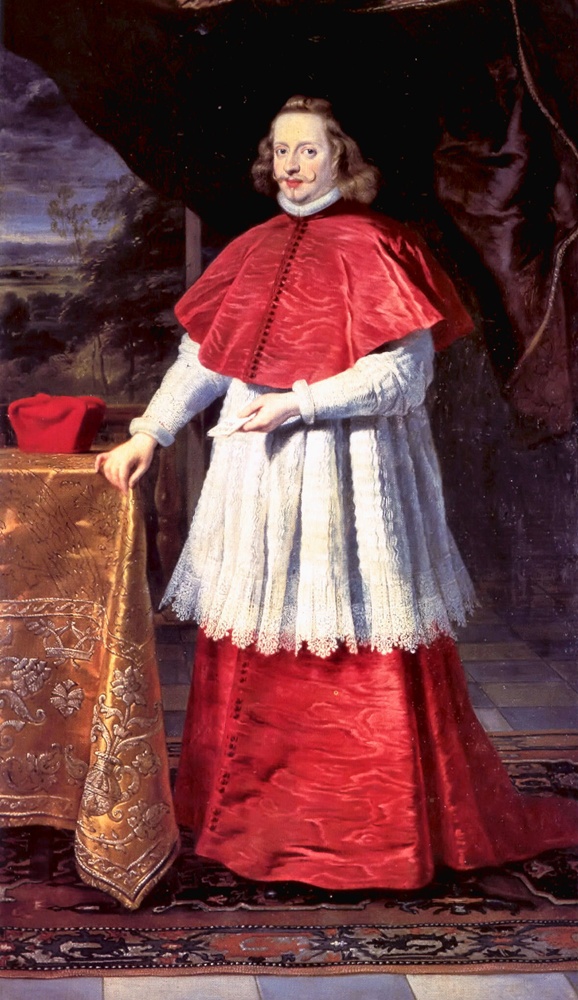Father:
Philip III of Spain (1578-1621)
Mother:
Margaret of Austria (1584-1611)
____________________________________________________
Born in Escorial near Madrid, Spain in 1609 as the son of King of Spain, Philip III, brother of King of Spain Philip IV, and Margaret of Austria, sister of Emperor Ferdinand II. His father wished that he make his career in the Catholic Church, and hence in 1619 he was made Archbishop of Toledo, and shortly afterwards received the title of Cardinal. The style Cardinal-Infante was a combination of his title of Cardinal and his title as a Prince (Infante in Spanish) of Spain. Ferdinand was never ordained as a Priest, which was not unusual for royalty and members of the aristocracy who were given clerical benifices.
In 1630 the Cardinal Infante's aunt Isabella Clara Eugenia planned to make him her successor as governor of the Spanish Netherlands. To move to the Netherlands in a style befitting to a governor, a strong army had to accompany him. Travel by ship from Spain was not an option, due to heavy risk of battle with the Dutch navy, regarded as unacceptable to bear up by a royal person. Therefore he went to Genoa in [[1633], so quitting his Governorship of Catalonia where he was duly trained, to meet with an army from Milan for a planned march through the famous Spanish Way across Lombardy, Tyrol, and Swabia, and then following the Rhine to the Netherlands. Ferdinand also planned to secure this supply route with a string of garrisons, and to support the army of King Ferdinand of Hungary, his uncle the emperor's son and heir, who was leading the Imperial army facing the Swedes in the Thirty Years' War. Since disease delayed his travels, he sent half of his army ahead under the command of the Duke of Feria. However, this army was severely depleted during fighting with the Swedish army of Bernhard of Saxe-Weimar and Gustaf Horn. The Spanish requested 4000 cavalry from the Imperial general Albrecht von Wallenstein, but since Wallenstein declined the request the Spanish had to fund the troops on their own. The Cardinal-Infante was able to continue his travels in 1634, collecting in Bavaria the remains of the Army of Gómez Suárez, who had died in January 1634.
Meanwhile, Ferdinand of Hungary was able to defeat the Swedish army at Regensburg in July 1634. This Ferdinand and his cousin the Cardinal-Infante Ferdinand then raced to merge their armies. The Swedish forces of Bernhard of Saxe-Weimar and Gustaf Horn desperately tried to prevent this merger, but were unable to catch up with Ferdinand of Hungary. The Cardinal-Infante crossed the Danube in August 1634. In September both armies were able to merge, and camped south of Nördlingen in Swabia. At that time Nördlingen was protected by a small Swedish garrison. Shortly thereafter, the armies of Bernhard of Saxe-Weimar and Gustaf Horn also reached Nördlingen, preparing the events for the decisive Battle of Nördlingen. The cousins Ferdinand & Ferdinand then prepared for battle, ignoring the advice of the more experienced generals, such as the Imperial general Matthias Gallas. Bernhard and Horn also prepared for battle, but they were by now rivals and in disagreement with each other. They also underestimated the numerically superior enemy forces, due to incorrect reports that did not realize the Spanish Army of the late Duke of Feria had joined the Cardinal-Infante and believed that the enemy forces numbered only 7,000, not 21,000 infantry, compared to 16,000 Swedish infantry. During the battle, almost anything that could go wrong went wrong for the Swedish forces, due to the strong defensive efforts of the Spanish Infantry (the most feared "Tercios Viejos", mainly those commanded by Fuenclara, Idiáquez and Toralto) after pushing back fifteen Swedish assaults against Blue and Yellow Horn regiments on the hill of Albuch they protected, so the two Ferdinands achieved an outstanding military victory. Gustaf Horn was captured, the Swedish army was destroyed, and the remainder that fled to Heilbronn was only a shadow of the former glorious army. As a whole this battle proved that the deployment improvements deviced by Maurice of Orange and the late Swedish King did not match yet the old Tercio when Spanish troops were engaged in the fighting.
The King of Hungary tried to convince his cousin to stay and to strengthen their hold on Germany, but the Cardinal-Infante Ferdinand moved his troops almost immediately after the battle to continue to Brussels. At the end of 1634 he entered Brussels with all the glory befitting a Governor-General. Due to the unpopularity of the clergy in Brussels, he downplayed his religious status and instead emphasized his worldly ranks. Ferdinand was a skilled politician and diplomat, and quickly reformed the government and the military. He especially managed to win the support of the Flemings against France.
However, his powers were secretly limited, and the leader of his army was instructed to follow Spanish orders instead of Ferdinand's orders if necessary. In 1635 the French attacked Namur, planning to merge with the Dutch near Maastricht. However, the Dutch hesitated, and the French retreated. Ferdinand subsequently was able to capture Diest, Goch, Gennep, Limbourg, and Schenk.
In 1636 Ferdinand disempowered the last Protestant priests in the Spanish Netherlands, and continued his military expansion by capturing Hirsen, Châtelet, and Chapelle, and securing Luxembourg using the usual mixed nationalities of a Modern Age Army that included then Croatian troops, and reaching as far a stronghold in France as La Corbie, near Paris
On October 10, 1637, however, Breda was recaptured again after a 10 month siege by the Prince of Orange after being under Spanish control for 12 years. Despite repeated attempts the Cardinal-Infante was unable to recapture this critical fortress, strengthening not only the Dutch but also his enemies at the Spanish court in Madrid. Ferdinand also lost Chapelles, Landrey, and Damvilliers to the French, and was not only unable to capture Maubeuge but also lost significant ground to the French in the process. While Ferdinand was able to capture Antwerp, Chastillon, and Geldern in subsequent years, he lost the important town of Arras in 1640.
More dangerous than his military enemies were, however, his enemies at the Spanish court. Numerous rumors and lies floated about, and it was claimed that Ferdinand was planning to become an independent ruler of the Spanish Netherlands with the help of the French King, an enemy of Spain. This rumor was enhanced by another rumor that the French court was planning to marry Ferdinand to Anne Marie of Montpensier, the (eldest) daughter of Gaston, Duke of Orleans, the French king's brother. Both claims were totally without merit and only designed to hurt his reputation.
At the same time, the Spanish empire was in a bad state both military and financially. The Cardinal-Infante was even giving conflicting orders to send troops to Spain to aid against a Portuguese uprising.
Ferdinand fell ill during battles in 1641, and died on 9 November 1641 in Brussels at age 32. It is believed that the death was caused by exhaustion combined with ill health. Reports talk about a stomach ulcer, but rumors also claimed that he was poisoned. Before his death he had an illegitimate daughter, Marie Anne de la Croix, born in Brussels in 1641 and died a nun in Madrid in 1715.
Source:
http://en.wikipedia.org/wiki/Cardinal-Infante_Ferdinand
Father:
Philip III of Spain (1578-1621)
Mother:
Margaret of Austria (1584-1611)
____________________________________________________
Born in Escorial near Madrid, Spain in 1609 as the son of King of Spain, Philip III, brother of King of Spain Philip IV, and Margaret of Austria, sister of Emperor Ferdinand II. His father wished that he make his career in the Catholic Church, and hence in 1619 he was made Archbishop of Toledo, and shortly afterwards received the title of Cardinal. The style Cardinal-Infante was a combination of his title of Cardinal and his title as a Prince (Infante in Spanish) of Spain. Ferdinand was never ordained as a Priest, which was not unusual for royalty and members of the aristocracy who were given clerical benifices.
In 1630 the Cardinal Infante's aunt Isabella Clara Eugenia planned to make him her successor as governor of the Spanish Netherlands. To move to the Netherlands in a style befitting to a governor, a strong army had to accompany him. Travel by ship from Spain was not an option, due to heavy risk of battle with the Dutch navy, regarded as unacceptable to bear up by a royal person. Therefore he went to Genoa in [[1633], so quitting his Governorship of Catalonia where he was duly trained, to meet with an army from Milan for a planned march through the famous Spanish Way across Lombardy, Tyrol, and Swabia, and then following the Rhine to the Netherlands. Ferdinand also planned to secure this supply route with a string of garrisons, and to support the army of King Ferdinand of Hungary, his uncle the emperor's son and heir, who was leading the Imperial army facing the Swedes in the Thirty Years' War. Since disease delayed his travels, he sent half of his army ahead under the command of the Duke of Feria. However, this army was severely depleted during fighting with the Swedish army of Bernhard of Saxe-Weimar and Gustaf Horn. The Spanish requested 4000 cavalry from the Imperial general Albrecht von Wallenstein, but since Wallenstein declined the request the Spanish had to fund the troops on their own. The Cardinal-Infante was able to continue his travels in 1634, collecting in Bavaria the remains of the Army of Gómez Suárez, who had died in January 1634.
Meanwhile, Ferdinand of Hungary was able to defeat the Swedish army at Regensburg in July 1634. This Ferdinand and his cousin the Cardinal-Infante Ferdinand then raced to merge their armies. The Swedish forces of Bernhard of Saxe-Weimar and Gustaf Horn desperately tried to prevent this merger, but were unable to catch up with Ferdinand of Hungary. The Cardinal-Infante crossed the Danube in August 1634. In September both armies were able to merge, and camped south of Nördlingen in Swabia. At that time Nördlingen was protected by a small Swedish garrison. Shortly thereafter, the armies of Bernhard of Saxe-Weimar and Gustaf Horn also reached Nördlingen, preparing the events for the decisive Battle of Nördlingen. The cousins Ferdinand & Ferdinand then prepared for battle, ignoring the advice of the more experienced generals, such as the Imperial general Matthias Gallas. Bernhard and Horn also prepared for battle, but they were by now rivals and in disagreement with each other. They also underestimated the numerically superior enemy forces, due to incorrect reports that did not realize the Spanish Army of the late Duke of Feria had joined the Cardinal-Infante and believed that the enemy forces numbered only 7,000, not 21,000 infantry, compared to 16,000 Swedish infantry. During the battle, almost anything that could go wrong went wrong for the Swedish forces, due to the strong defensive efforts of the Spanish Infantry (the most feared "Tercios Viejos", mainly those commanded by Fuenclara, Idiáquez and Toralto) after pushing back fifteen Swedish assaults against Blue and Yellow Horn regiments on the hill of Albuch they protected, so the two Ferdinands achieved an outstanding military victory. Gustaf Horn was captured, the Swedish army was destroyed, and the remainder that fled to Heilbronn was only a shadow of the former glorious army. As a whole this battle proved that the deployment improvements deviced by Maurice of Orange and the late Swedish King did not match yet the old Tercio when Spanish troops were engaged in the fighting.
The King of Hungary tried to convince his cousin to stay and to strengthen their hold on Germany, but the Cardinal-Infante Ferdinand moved his troops almost immediately after the battle to continue to Brussels. At the end of 1634 he entered Brussels with all the glory befitting a Governor-General. Due to the unpopularity of the clergy in Brussels, he downplayed his religious status and instead emphasized his worldly ranks. Ferdinand was a skilled politician and diplomat, and quickly reformed the government and the military. He especially managed to win the support of the Flemings against France.
However, his powers were secretly limited, and the leader of his army was instructed to follow Spanish orders instead of Ferdinand's orders if necessary. In 1635 the French attacked Namur, planning to merge with the Dutch near Maastricht. However, the Dutch hesitated, and the French retreated. Ferdinand subsequently was able to capture Diest, Goch, Gennep, Limbourg, and Schenk.
In 1636 Ferdinand disempowered the last Protestant priests in the Spanish Netherlands, and continued his military expansion by capturing Hirsen, Châtelet, and Chapelle, and securing Luxembourg using the usual mixed nationalities of a Modern Age Army that included then Croatian troops, and reaching as far a stronghold in France as La Corbie, near Paris
On October 10, 1637, however, Breda was recaptured again after a 10 month siege by the Prince of Orange after being under Spanish control for 12 years. Despite repeated attempts the Cardinal-Infante was unable to recapture this critical fortress, strengthening not only the Dutch but also his enemies at the Spanish court in Madrid. Ferdinand also lost Chapelles, Landrey, and Damvilliers to the French, and was not only unable to capture Maubeuge but also lost significant ground to the French in the process. While Ferdinand was able to capture Antwerp, Chastillon, and Geldern in subsequent years, he lost the important town of Arras in 1640.
More dangerous than his military enemies were, however, his enemies at the Spanish court. Numerous rumors and lies floated about, and it was claimed that Ferdinand was planning to become an independent ruler of the Spanish Netherlands with the help of the French King, an enemy of Spain. This rumor was enhanced by another rumor that the French court was planning to marry Ferdinand to Anne Marie of Montpensier, the (eldest) daughter of Gaston, Duke of Orleans, the French king's brother. Both claims were totally without merit and only designed to hurt his reputation.
At the same time, the Spanish empire was in a bad state both military and financially. The Cardinal-Infante was even giving conflicting orders to send troops to Spain to aid against a Portuguese uprising.
Ferdinand fell ill during battles in 1641, and died on 9 November 1641 in Brussels at age 32. It is believed that the death was caused by exhaustion combined with ill health. Reports talk about a stomach ulcer, but rumors also claimed that he was poisoned. Before his death he had an illegitimate daughter, Marie Anne de la Croix, born in Brussels in 1641 and died a nun in Madrid in 1715.
Source:
http://en.wikipedia.org/wiki/Cardinal-Infante_Ferdinand
Family Members
Advertisement
Records on Ancestry
Sponsored by Ancestry
Advertisement











